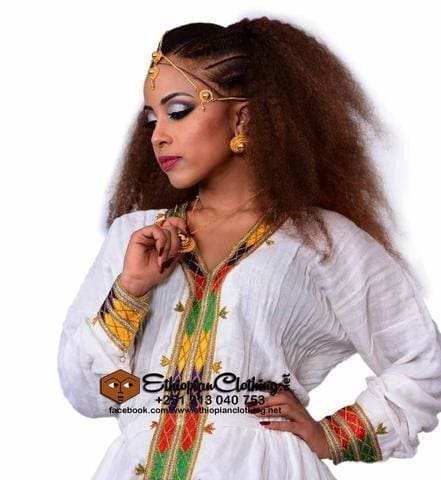It has been reported that the goal of Ethiopia is to produce a 30 billion dollar export revenue from apparel and textile annually by 2025. This shows that this country aims to leave behind many other top exporters including Bangladesh and Vietnam in just less than a decade. The sector stakeholders believe that this shows that how fashion designers in Ethiopia are dedicated and how Ethiopian fashion is a promising sign that the worldwide fashion industry is embracing at an exciting pace.
There are a number of factors that have shaped the competitiveness of the fashion industry. Amongst them, Ethiopian traditional dress, popularly known as Habesha kemis is the most beautifully designed and well-known dress for cultural holidays and events in Ethiopia and Eritrea.
Basically, there is a wide variety of traditional dresses that Ethiopians and Eritreans like to wear. The unique style of hand embroidery handwoven pattern on their dresses is what makes this Eritrean cultural dress and Ethiopian traditional dress entirely different from others.
SOME QUICK FACTS ABOUT ETHIOPIA
Before we discuss more the Ethiopian traditional dress, Habesha kemis, let’s first have a look at some quick facts of Ethiopia, which will give an overview of this country and its tradition. This country is situated on the horn of Africa. Not only this, but this country has the second largest population in Africa with around ninety-six million people. Ethiopia has archaeological digs that yield the oldest signs of humanity. This country is bordered by South Sudan and Sudan to the west, Somalia, and Djibouti to the east, Kenya to the south and Eritrea to the north, therefore it is a landlocked country.
CLOTHING FACTS OF ETHIOPIA
It is true that the type of dressing people wear reflects the landscape and climate of the specific region they are living in. For example, heavy clothing is done by Highlanders to secure themselves from the low temperatures, however, people that are living in the lowland plains, wear light clothing as it is quite hot there.
Even though there is an extensive variety of clothing worn in Ethiopia, Ethiopia traditional dress is said to be the most beautiful dressing of all. Habesha kemis is a white handwoven cotton clothing that can be seen in several parts of the country.

WHAT IS HABESHA KEMIS AND WHY IT IS SO POPULAR?
Habesha, also known as Abyssinians a population group that is inhabited in the horn of Africa in Eritrea and Ethiopia. This dress is so popular that is worn on everyday occasions. During special events and ceremonies, such as New Year evening, Christmas party or wedding, they wear this special Ethiopian traditional dress, known as Habesha kemis which is loved and appreciated by all.
Habesha Kemis is an ankle length dress which is worn by Eritrean and Ethiopian women at formal events as well as at casual occasions. This sensual Ethiopian traditional dress is accompanied by sleeves and a bodice. However, nowadays, it comes in a number of forms. The fabric which is used to make this dress is cotton. This cotton fabric is known as shemma handwoven by traditional weaver called Shemane. The shemma fabric is around 75 cm wide and it is woven into long stripes. These stripes are sewn together. For an elegant effect, sometimes bright yarns are also woven into the fabric.
This Eritrean cultural dress is decorated with hand embroidery and tilet or tibeb (handwoven pattern) of bright and beautiful colors on the top and middle of the dress as well as on the bottom, wrist, and neck.
Women like to wear a scarf or light shawl around the waist known as netsela or netela which matches the fabric and pattern of the dress. This shawl can also be worn on the shoulders and neck. The popular and major shades in which this dress comes, include beige, white and grey shades. To add more beauty to this Eritrean cultural dress, many women wear beautiful Ethiopian fashion jewelry with it.
The traditional jewelry that is worn along with the dress is usually made up of ivory, amber, bronze, gold, and silver. Generally, women in Ethiopia and Eritrea love to wear earrings, bracelets, and necklaces with Habesha kemis .
In Australia, Europe, and North America, Habesha kemis is retailed at “Eritrean markets” or “Ethiopian markets”. There are a number of Eritrean markets that source this beautiful Ethiopian traditional dress from Ethiopia. Since it is a tradition to wear Habesha Kemis in Eritrea, So whenever a non-Ethiopian wears Habesha kemis, it is greatly appreciated by Ethiopians.
In the countryside, this traditional clothing in Ethiopia is worn on a daily basis by many people. Nowadays, the western style dressing is becoming popular day by day in large town and cities. But, still, there are a number of older people in large town and cities who still wear this Ethiopian traditional dress.




Thanks for the insight!